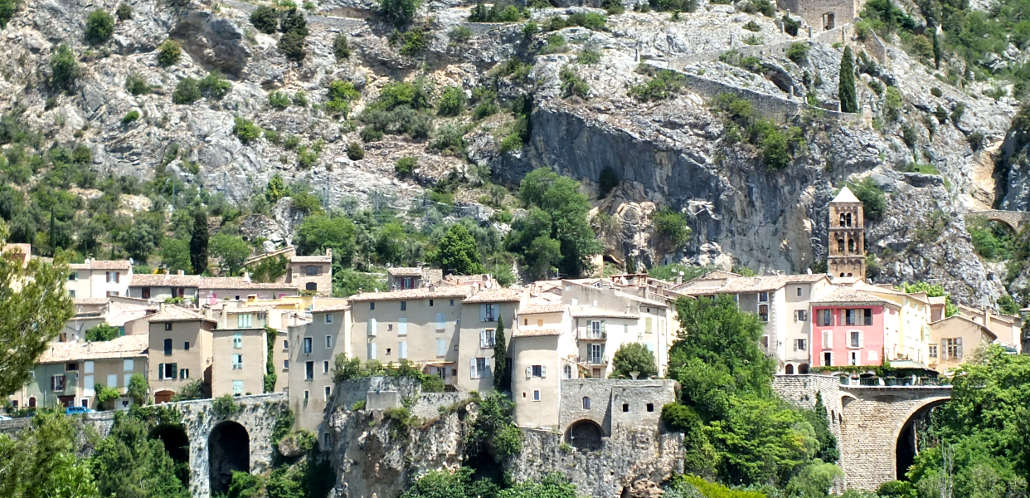
Natural and historic heritage in Provence
The Gitelink guide to Provence
►
You
are here:
Gitelink
France >
Provence
gites &
cottages
> Provence heritage
It is hardly surprising that Provence is the most popular region in France for tourists and holidaymakers; it is a region that has it all! While some regions have just a great seaside, others have a great natural environment, and others have a great cultural heritage, Provence is a region that has all three.
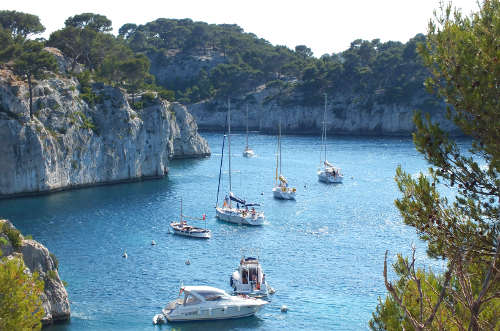
In the Calanques National Park, on the coast near Cassis
Many travellers might indeed be hard-pressed to
find a downside to this magnificent region in the south of France; but
in all fairness, Provence should not be thought of as a sort
of Heaven on Earth; drivers stuck in a motorway traffic jam on a
Saturday afternoon in mid summer might be forgiven for thinking that
Provence is Hell on Earth. Overcrowded resorts and beaches, expensive
facilities, high temperatures, traffic jams – all of these
can be considered as the downside to holidays in Provence and the
Riviera, specially in July and August. But as far as heritage is
concerned, this is a region that has it all.
Surprisingly for a country its size, continental France only has seven National Parks; but four of these are in Provence. The region also has four very different regional nature parks or natural reserves (called Parcs naturels régionaux in French), plus a couple of other sites of great environmental interest. Over and above this, other large expanses of the Provece countryside, notably in the hills, are designated as environmental protection areas under the European Natura 2000 programme. The region also has three of the seven UNESCO biosphere reserves in France.
The three national parks are all situated on the very edge of the region, two of them along the Italian border, and one on the coast. The Parc National du Mercantour (website) is a high alpine park, culminating at the Cime du Gélas - 3143 metres - on the Italian border. The park runs for 80 km from Sospel in the south, to Meyronnes in the north. The park is very popular with hikers and ramblers, and like most such areas has a network of well signed footpaths. It is rich in wildlife, both flora and fauna, and among the more unusual creatures to be found (or perhaps not found) are wolves. Though local shepherds keep protesting at the loss of sheep, there have been no reported incidents of humans being attacked. Other less daunting creatures to be seen in the Mercantour include marmots, chamois, wild goats and - in the sky - golden eagles and Egyptian vultures.
The Parc national des Ecrins is partly in Provence, partly in the Rhone-alpes region to the north. Like the Mercantour, it is a high Alpine park, popular with hikers. there are over 700 kilometres of marked paths. The area is also popular with mountaineers, thanks to its high peaks, the highest of which , La Barre des Ecrins, reaches an altitude of 4101 metres (13,455 ft).
The Parc National de Port Cros is France's only coastal national park, and includes small areas on the mainland, and a couple of islands just off the shore. It is located near Saint Tropez, where the Esterel hills come down to the shore. The park, which of course has an interesting visitor centre, includes not just the land, but the coastal waters offshore.
The fourth National Park is new. Designated in 2012, the Park National des Calanques covers the remarkable rocky arid coastline just east of Marseilles. The calanques themselves are narrow inlets like small fijords along the coast.
The Luberon; this dry hilly area stretches for some sixty kilometres east of the Rhone valley. It includes traditional Provençal countryside, with fields and orchards, as well as picturesque villages and dry hillsides. The area is popular with artists, and also has many kilometres of hiking trails. The Luberon is also a UNESCO biosphere reserve.
The Queyras: this regional natural park is situated between the Ecrins national park and the Italian border. It is similar in nature to the two Alpine national parks.
The Verdon : this is a spectacular area of dry mountains and steep valleys and gorges. The Verdon canyon is the biggest canyon in Europe, and almost 1000 ft deep in places. The surging torrents at the foot of steep gorges are popular for adventure sports, such as rafting, kayaking and canyoning.
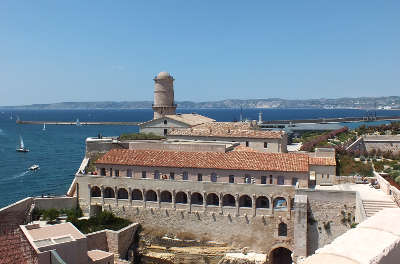
King René's fort, guarding the entrance to the old port at Marseille
Mediaeval:
as a key location on the interface between the civilisations of
northern Europe and those of the Mediterranean basin, Provence has been
a strategically important region throughout its history, and different
eras have left their mark. Among the most interesting medieval
monuments in this region are the church andcloisters of Saint
Trophime,
in Arles,
which are among the finest decorated romanesque monuments in
the south of France. Not far from Arles, the church and cloister of Saint Paul de Mausolle,
at Saint-Rémy,
are also worth a visit. Less
spectacular,
but highly visible standing as it does in a site
overlooking
the lower Rhone valley, is the church of St Michel at La
Garde Adhémar, near Orange.
The oldest church in Marseilles,
Saint Victor,
dates
from the XIth and XIIth centuries.
The most visited mediaeval monument in Provence is the Palais des Papes / Palace of the Popes in Avignon, once the seat of the papacy at a time when Rome was too dangerous; for centuries, the area around Avignon was a papal enclave, belonging to the Holy See.
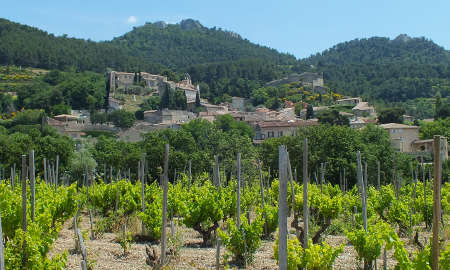
Provence has been producing wine since Roman times or earlier
Another much visited site is the
historic city of Les
Baux de Provence:
standing at the edge of the Alpilles hills, overlooking the Rhone
delta, Les Baux was once a small thriving city. Over the
centuries, it fell into abandon and was, until the 1960's,
largely a ruined ghost town. Since then it has been partly renovated,
and partly preserved as a historic monument
Apart from that, the Provence Alpes Côte d'Azur region offers a wealth of old towns and villages, with narrow streets and buildings dating back to the Middle Ages. In lower Provence", many of the villages stand amid vineyards, some of which have been pr(oducing wine since Roman times.
Two jewels in the crown are the old city of Aix en Provence, with its historic buildings and museums, and the the hill town of Saint Paul de Vence, near Nice, a famed retreat for artists and home to one of the best private art galleries in France..
The fabulous heritage of Provence
| Jump to | Provence natural heritage | Provence historic
heritage |
It is hardly surprising that Provence is the most popular region in France for tourists and holidaymakers; it is a region that has it all! While some regions have just a great seaside, others have a great natural environment, and others have a great cultural heritage, Provence is a region that has all three.

In the Calanques National Park, on the coast near Cassis
Provence's Natural Heritage
Like California, the Provence - Riviera region is one which not only has beaches where people can be seen stretched out on the sand even in winter; it also has high Alpine peaks where the snow still lies even in summer; and the two are less than 100 km. apart.Surprisingly for a country its size, continental France only has seven National Parks; but four of these are in Provence. The region also has four very different regional nature parks or natural reserves (called Parcs naturels régionaux in French), plus a couple of other sites of great environmental interest. Over and above this, other large expanses of the Provece countryside, notably in the hills, are designated as environmental protection areas under the European Natura 2000 programme. The region also has three of the seven UNESCO biosphere reserves in France.
The three national parks are all situated on the very edge of the region, two of them along the Italian border, and one on the coast. The Parc National du Mercantour (website) is a high alpine park, culminating at the Cime du Gélas - 3143 metres - on the Italian border. The park runs for 80 km from Sospel in the south, to Meyronnes in the north. The park is very popular with hikers and ramblers, and like most such areas has a network of well signed footpaths. It is rich in wildlife, both flora and fauna, and among the more unusual creatures to be found (or perhaps not found) are wolves. Though local shepherds keep protesting at the loss of sheep, there have been no reported incidents of humans being attacked. Other less daunting creatures to be seen in the Mercantour include marmots, chamois, wild goats and - in the sky - golden eagles and Egyptian vultures.
The Parc national des Ecrins is partly in Provence, partly in the Rhone-alpes region to the north. Like the Mercantour, it is a high Alpine park, popular with hikers. there are over 700 kilometres of marked paths. The area is also popular with mountaineers, thanks to its high peaks, the highest of which , La Barre des Ecrins, reaches an altitude of 4101 metres (13,455 ft).
The Parc National de Port Cros is France's only coastal national park, and includes small areas on the mainland, and a couple of islands just off the shore. It is located near Saint Tropez, where the Esterel hills come down to the shore. The park, which of course has an interesting visitor centre, includes not just the land, but the coastal waters offshore.
The fourth National Park is new. Designated in 2012, the Park National des Calanques covers the remarkable rocky arid coastline just east of Marseilles. The calanques themselves are narrow inlets like small fijords along the coast.
Regional Natural parks
The Camargue is one of the major wetlands of Europe; located in the rhone delta, it is on the migratory path for hundreds of thousands of birds each year, and consequently is very popular with birdwatchers. Over 400 species of bird can be seen in the Camargue, and the most popular of these are undoubtedly the pink flamingos; the Camargue is, the only area in France where these Mediterranean birds can be seen. The area is also famous for its white Camaguais horses, and for the black bulls that are raised here. About a third of the area is marsh or lake. Other parts are used for agriculture, including the cultivation of rice. The Camargueis one of seven UNESCO biosphere reserves in France.The Luberon; this dry hilly area stretches for some sixty kilometres east of the Rhone valley. It includes traditional Provençal countryside, with fields and orchards, as well as picturesque villages and dry hillsides. The area is popular with artists, and also has many kilometres of hiking trails. The Luberon is also a UNESCO biosphere reserve.
The Queyras: this regional natural park is situated between the Ecrins national park and the Italian border. It is similar in nature to the two Alpine national parks.
The Verdon : this is a spectacular area of dry mountains and steep valleys and gorges. The Verdon canyon is the biggest canyon in Europe, and almost 1000 ft deep in places. The surging torrents at the foot of steep gorges are popular for adventure sports, such as rafting, kayaking and canyoning.
Provence's historic heritage
Classical antiquity. With a civilisation stretching back further than that of northern France, and Marseilles being the oldest city in France, Provence offers a remarkable cultural heritage, and one of the finest collections of Roman remains to be found anywhere in Europe. Taking into account modern Provence plus the area around Nimes, the sector boasts a variety of Roman remains, including arenas (Nimes, Arles), amphitheatres (Orange, Arles), temples (including the remarkably well preserved Maison Carrée at Nimes), triumphal arches (Glanum, St Rémy, and Orange), aqueducts (Pont du Gard and Barbegal) and other monuments such as La Trophée des Alpes at La Turbie or villas as at Vaison la Romaine. There are also museums of antiquity at Vaison, Arles, Marseilles and other places.
King René's fort, guarding the entrance to the old port at Marseille
The most visited mediaeval monument in Provence is the Palais des Papes / Palace of the Popes in Avignon, once the seat of the papacy at a time when Rome was too dangerous; for centuries, the area around Avignon was a papal enclave, belonging to the Holy See.

Provence has been producing wine since Roman times or earlier
Apart from that, the Provence Alpes Côte d'Azur region offers a wealth of old towns and villages, with narrow streets and buildings dating back to the Middle Ages. In lower Provence", many of the villages stand amid vineyards, some of which have been pr(oducing wine since Roman times.
Two jewels in the crown are the old city of Aix en Provence, with its historic buildings and museums, and the the hill town of Saint Paul de Vence, near Nice, a famed retreat for artists and home to one of the best private art galleries in France..

Provence region, covering the French Riviera, the Provence Alps, historic Provence and the area historically linked to Provence
A Gitelink
guide
| Other useful resources |
| Provence online resources |
| Gites and villas in Provence |
| Regional tourist office |
| Driving in France |
| Bed and breakfast in France |
| Rural camping in the south of France |
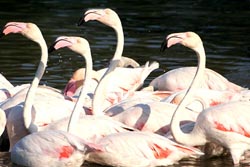
Flamingoes in the Camargue
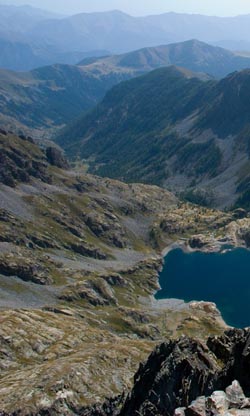
Mercantour national park
Copyright :
Website and text © Gitelink.com renewed 2021
.
